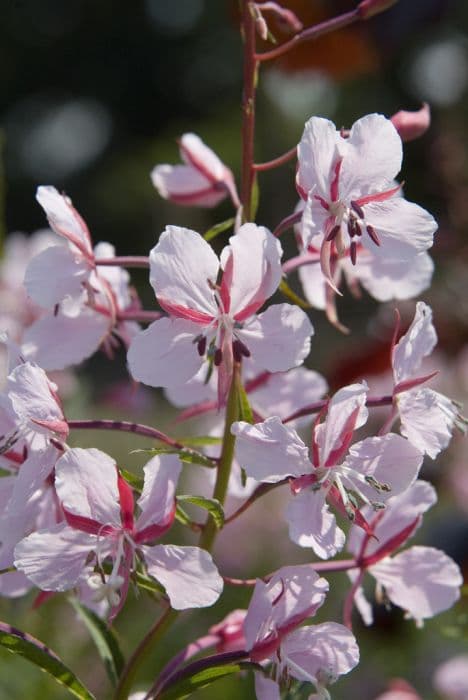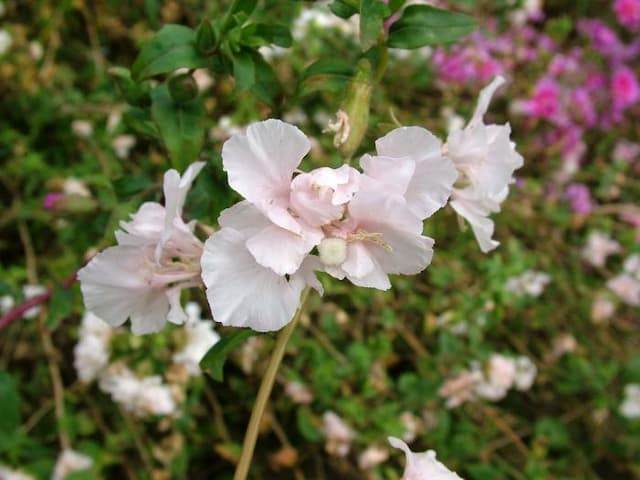Fuchsia Fuchsia 'Army Nurse' (d)

ABOUT
Fuchsia 'Army Nurse' is a beautiful ornamental plant that is cherished for its striking flowers and lush foliage. The blooms of this Fuchsia plant are particularly eye-catching; they hang from the branches like delicate earrings, displaying a stunning combination of colors. The flowers typically have a two-tone appearance, with outer petals that can vary from pink to a lighter shade, often creating a lovely, soft contrast with the rich purple or violet inner petals that form a skirt-like structure. The inner petals also extend into long, slender tubes that are either the same shade of purple or a contrasting hue, adding to the depth and intricacy of the flower's appearance. The stamens protrude elegantly from the center of the flower, often tipped with pollen that could be a shade of blue or purple, contributing to the plant's overall exotic look. The foliage of the Fuchsia 'Army Nurse' adds a lush backdrop to the vibrant blooms, with leaves that are usually a deep green with a slightly glossy finish. The leaves can have a delicate shape, with soft serration at the edges, which complements the overall ornate nature of the plant. The branches are graceful and may arch or droop slightly under the weight of the flowers, providing a beautiful display when the plant is in full bloom. The contrast between the green of the leaves and the vivid colors of the flowers makes the Fuchsia 'Army Nurse' a popular choice for adding visual interest to gardens and outdoor spaces.
About this plant
 Names
NamesFamily
Onagraceae
Synonyms
Lady's Eardrops, Fuchsia
Common names
Fuchsia 'Army Nurse'
 Toxicity
ToxicityTo humans
Fuchsias, including the 'Army Nurse' cultivar, are generally considered non-toxic to humans. Therefore, ingestion of this plant typically does not lead to serious poisoning. However, some individuals may experience mild gastrointestinal discomfort if they ingest parts of the fuchsia plant, such as the berries or leaves. Symptoms such as nausea, vomiting, or diarrhea can occur, but these are rare and usually self-limiting.
To pets
Fuchsias, including the 'Army Nurse' variety, are typically considered non-toxic to pets as well. They are not known to cause serious poisoning in animals like dogs and cats. However, as with humans, some pets may experience mild gastrointestinal upset if they ingest parts of the plant, with symptoms possibly including vomiting or diarrhea. If you suspect your pet has eaten a sizable amount of the plant and is showing symptoms of distress, it's advisable to contact a veterinarian.
 Characteristics
CharacteristicsLife cycle
Perennials
Foliage type
Deciduous
Color of leaves
Green
Flower color
Pink
Height
1-2 feet (30-60 cm)
Spread
1-2 feet (30-60 cm)
Plant type
Shrub
Hardiness zones
9
Native area
Central and South America
Benefits
 General Benefits
General Benefits- Attractive Flowers: Fuchsia 'Army Nurse' is known for its showy, pendulous flowers that add a splash of color and visual interest to gardens and containers.
- Habitat for Wildlife: Its blossoms can attract hummingbirds and pollinators such as bees, providing a food source and aiding in the pollination of other plants.
- Versatility: This plant is suitable for a variety of garden settings, including borders, hanging baskets, and as a standalone specimen.
- Shade Tollerent: Fuchsia 'Army Nurse' can flourish in partial shade, making it ideal for cooler, shaded areas where other sun-loving plants might struggle.
- Long Blooming Period: It has a long flowering season, often blooming from late spring through frost, giving gardeners a consistent display of color.
 Medical Properties
Medical PropertiesThis plant is not used for medical purposes.
 Air-purifying Qualities
Air-purifying QualitiesThis plant is not specifically known for air purifying qualities.
 Other Uses
Other Uses- Fuchsia 'Army Nurse' can be used in flower arranging due to its striking hanging flowers which add both color and an elegant drooping form to arrangements.
- The vibrant blossoms of the fuchsia can be used as natural dye for textiles, giving fabrics a soft pink to purple hue.
- Pressed fuchsia flowers are excellent for botanical art and crafts, including bookmarks, greeting cards, or framed nature displays.
- Fuchsia plants act as a habitat for beneficial insects, offering shelter and nectar in a garden ecosystem.
- The rich nectar of fuchsia flowers can be used to produce a distinct floral honey if bees are given access to a large number of fuchsia blooms.
- Edible parts of fuchsia, such as the berries, can be utilized in culinary arts for creating exotic garnishes on desserts and specialty dishes.
- Fuchsia can be incorporated into educational activities, such as teaching children about plant biology and pollination through hands-on garden experience.
- Fuchsia plants can be used in sensory gardens, offering a range of textures and colors that can be therapeutic to sight and touch.
- As a photography subject, the unique shape and vivid colors of fuchsia blossoms provide interesting focal points for botanical and macro photography.
- Using fuchsia plants in containers and hanging baskets can help create vertical gardens for spaces with limited planting area, such as balconies and patios.
Interesting Facts
 Feng Shui
Feng ShuiThe Fuchsia is not used in Feng Shui practice.
 Zodiac Sign Compitability
Zodiac Sign CompitabilityThe Fuchsia is not used in astrology practice.
 Plant Symbolism
Plant Symbolism- Confiding Love - Fuchsia 'Army Nurse' often symbolizes deep affection and trust, inviting confidences and secrets to be shared.
- Good Taste - The graceful hanging flowers of the Fuchsia are associated with having a good sense of aesthetics and refinement.
- Amiability - This plant conveys a gentle, amiable personality, often used in gardens to create a welcoming and kind atmosphere.
- Humble Love - Different from the grand gestures associated with roses, fuchsias symbolize a more modest, though profound, type of love.
- Elegance - The unique and elegant design of Fuchsia blooms are emblematic of grace and poise.
 Water
WaterThe Army Nurse Fuchsia requires consistent moisture, so water whenever the top inch of soil feels dry to the touch, which typically amounts to once or twice a week. During hot or windy weather, they may need water more frequently. The method should be gentle, avoiding water on the flowers and foliage to prevent disease. Each watering should provide enough water to soak the soil thoroughly; use about one gallon for outdoor plants, and for potted specimens, water until it runs out of the drainage holes.
 Light
LightThe Army Nurse Fuchsia thrives in a location that offers morning sunlight and afternoon shade. Bright, indirect light is best for this plant, as too much direct sun can scorch the leaves. An ideal spot would be under a tree with dappled sunlight or on a north- or east-facing windowsill inside the home.
 Temperature
TemperatureFuchsias, including the Army Nurse variety, prefer a cool climate and do best in a temperature range between 60 and 75 degrees Fahrenheit. They can survive temporarily down to 40 degrees Fahrenheit, but frost can be lethal so it's important to protect them from freezing temperatures.
 Pruning
PruningPruning is essential for the Army Nurse Fuchsia to maintain a compact shape and encourage more blooms. Prune in late winter or early spring before new growth begins. Remove dead or weak branches and cut back by one-third to one-half to promote vigorous growth. Pruning can also be done after the first flush of flowers has faded to stimulate a second blooming.
 Cleaning
CleaningAs needed
 Soil
SoilFuchsia 'Army Nurse' prefers a rich, fertile, and well-draining soil mix with a pH between 6.0 and 7.0. A good recipe would be to combine two parts peat moss with one part perlite and one part loamy soil, ensuring that the mix remains moist but not soggy.
 Repotting
RepottingFuchsias, including the 'Army Nurse' variety, should be repotted annually to refresh the soil and accommodate root growth. It's best to repot them in the spring before new growth begins.
 Humidity & Misting
Humidity & MistingThe 'Army Nurse' Fuchsia thrives in high humidity environments, ideally between 60-70%. They appreciate a moist atmosphere but should not be in overly wet conditions to prevent diseases.
 Suitable locations
Suitable locationsIndoor
For indoor growth, provide bright, indirect light and consistent moisture.
Outdoor
Place in partial shade and shelter from strong winds.
Hardiness zone
6-11 USDA
 Life cycle
Life cycleThe life cycle of the Fuchsia 'Army Nurse' begins with the germination of seeds, which requires a warm environment and can take anywhere from a few weeks to a couple of months. Following germination, the seedlings grow into juvenile plants, developing a root system and foliage as they enter the vegetative stage. During the growing season, the plant enters the flowering stage, producing distinctive pendulous flowers with a combination of purple and pink colors, which can attract pollinators like hummingbirds and bees. After pollination, the flowers develop into small, dark-colored fruits, which can distribute seeds for propagation if not deadheaded. As a perennial, once the growing season concludes, the plant will enter a phase of dormancy during the colder months, especially in cooler climates, when it may lose some or all of its leaves. The Fuchsia 'Army Nurse' may require pruning in the dormant stage and protection from frost to ensure healthy regrowth in the following spring.
 Propogation
PropogationPropogation time
Spring-Early Summer
The Fuchsia 'Army Nurse', commonly referred to simply as fuchsia, can be propagated most successfully during spring through softwood cuttings. The process involves taking a 2 to 4-inch (5 to 10 cm) cutting from the tip of a branch, making sure to include a few leaves. This cutting should then be dipped in rooting hormone before being planted in a moist potting mix. To create a humid environment, the potted cutting can be covered with a plastic bag, ensuring that the bag doesn't touch the leaves. It's important to keep the soil moist but not waterlogged and to place the cutting in bright, indirect light until roots have developed, which usually occurs within three to four weeks. Once rooted, the young plant can be transferred to a larger pot to continue growing until it's ready to be planted out.









